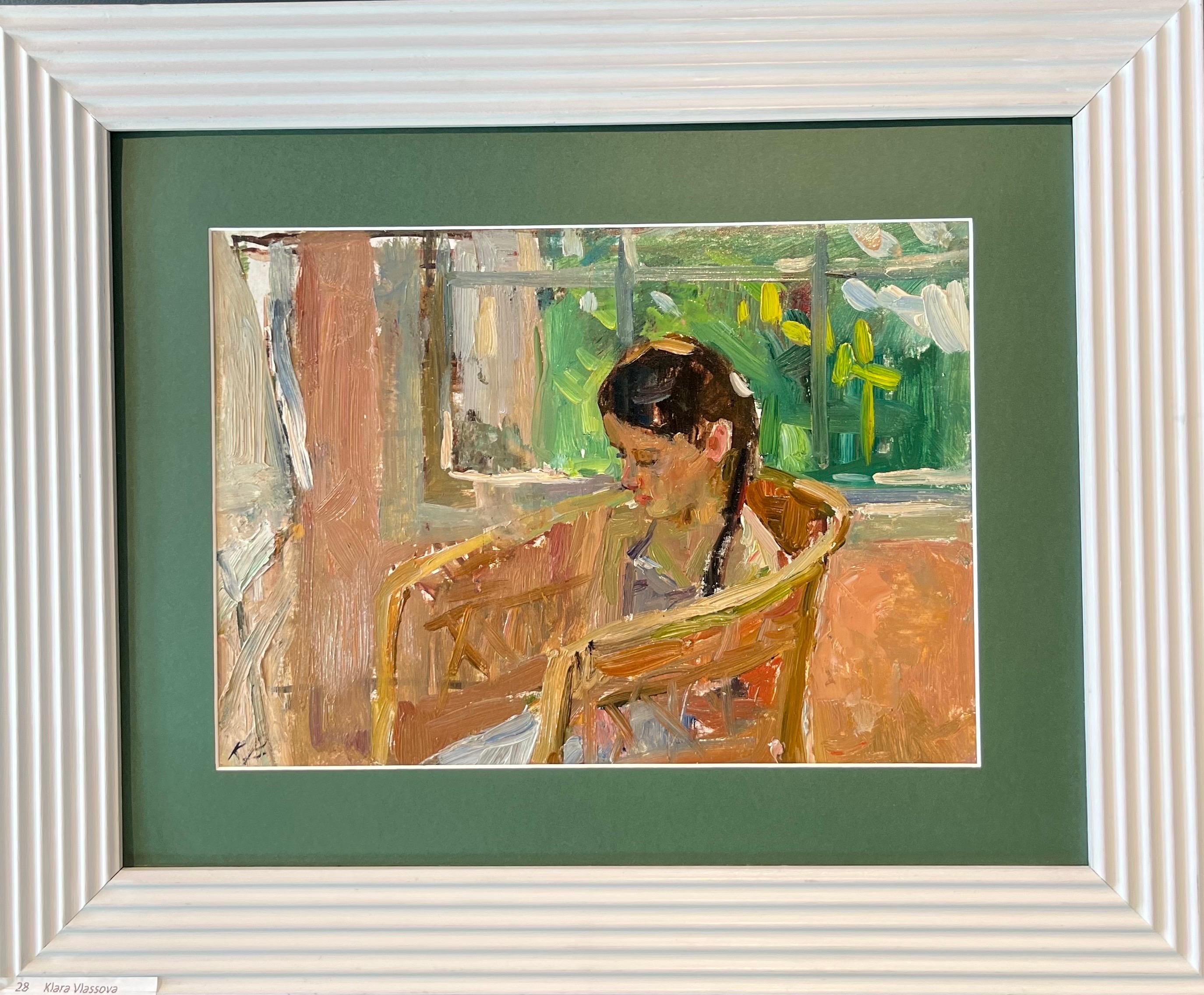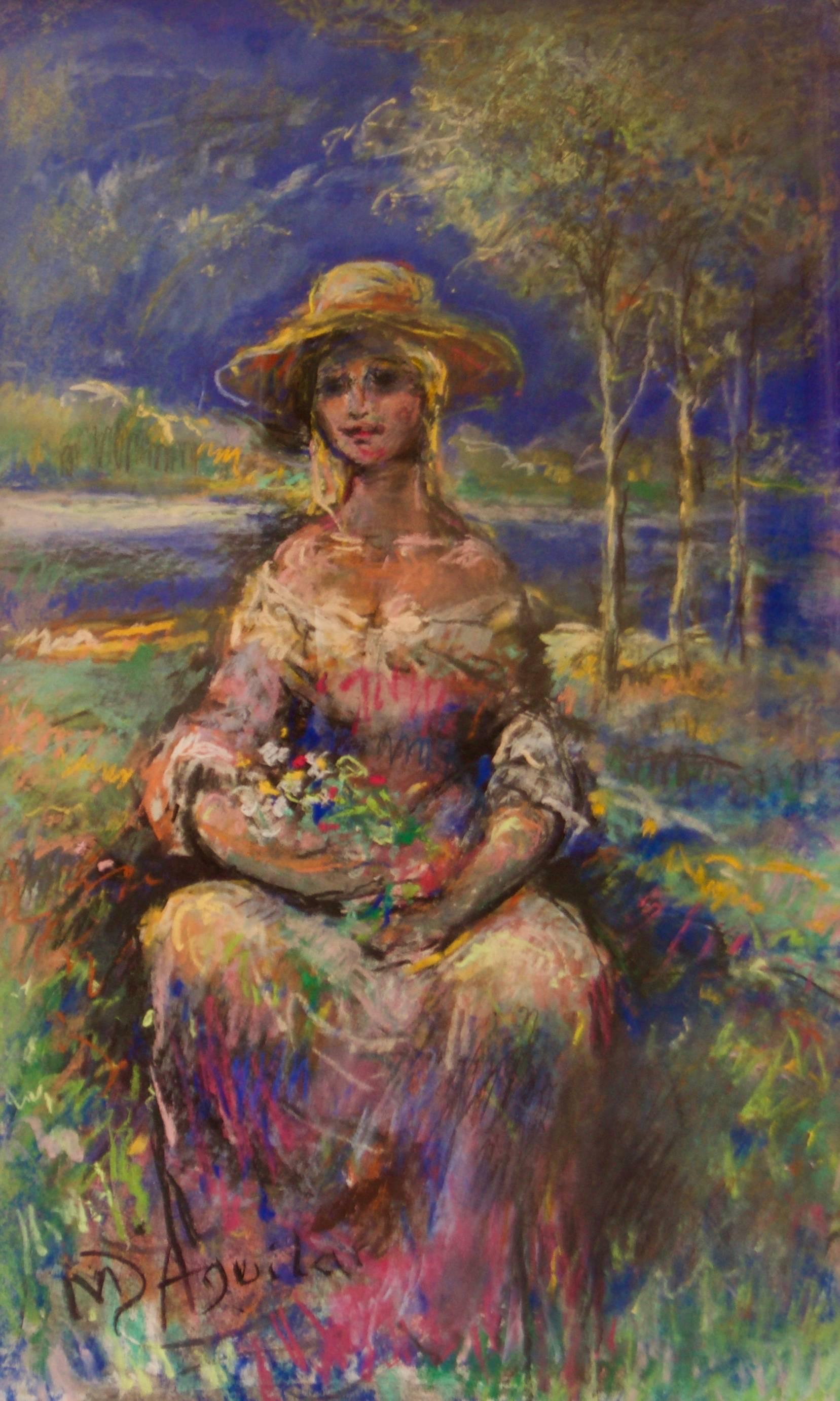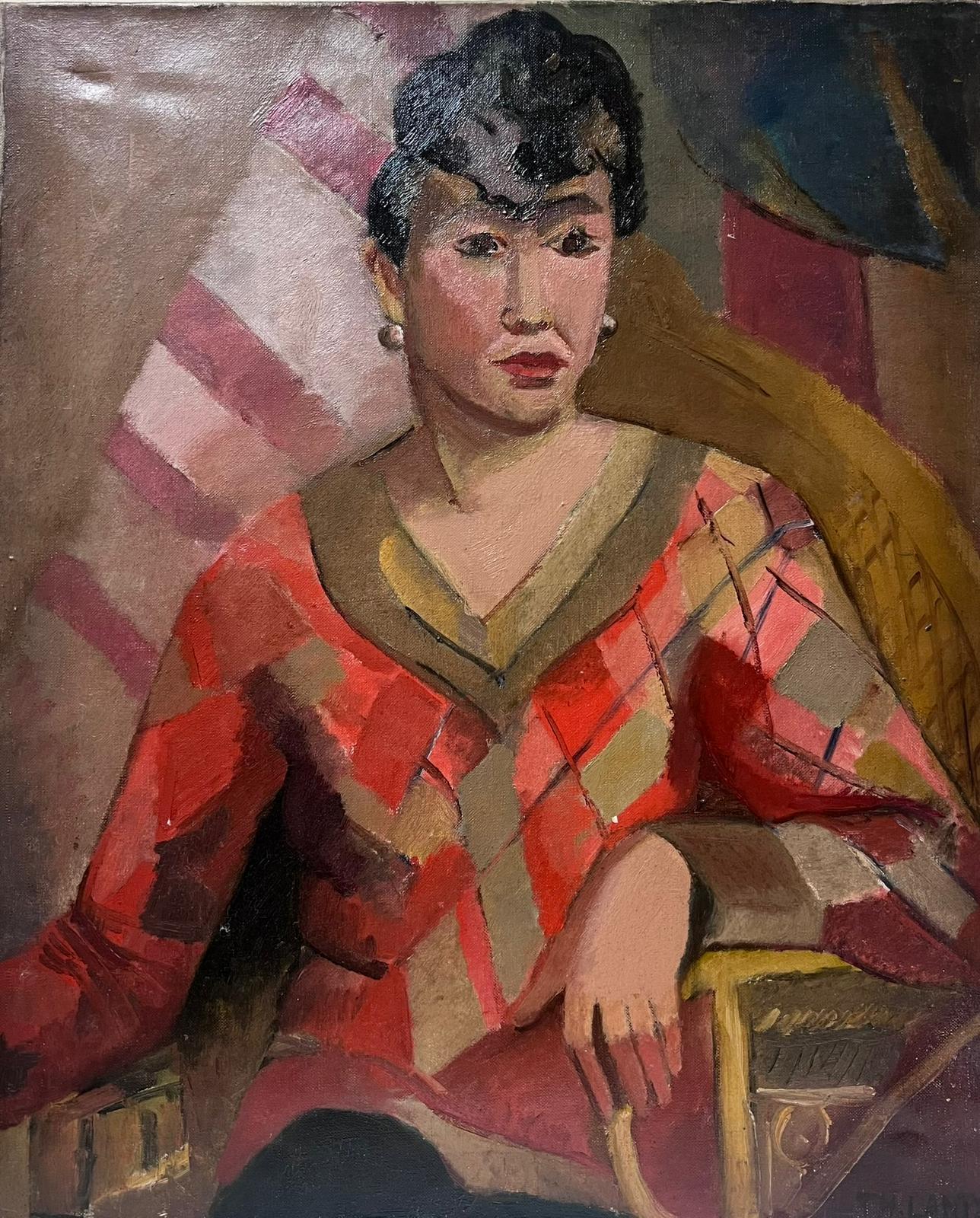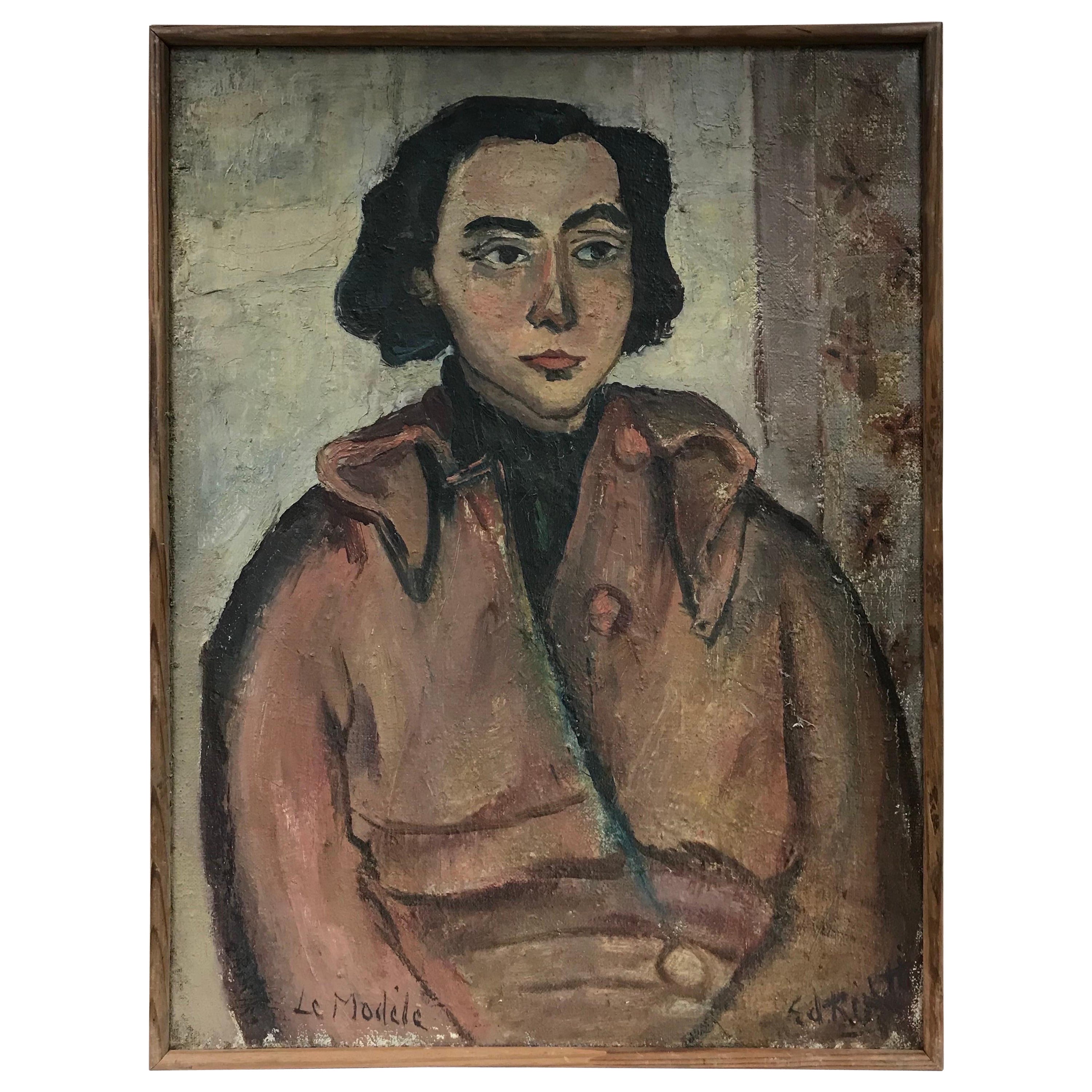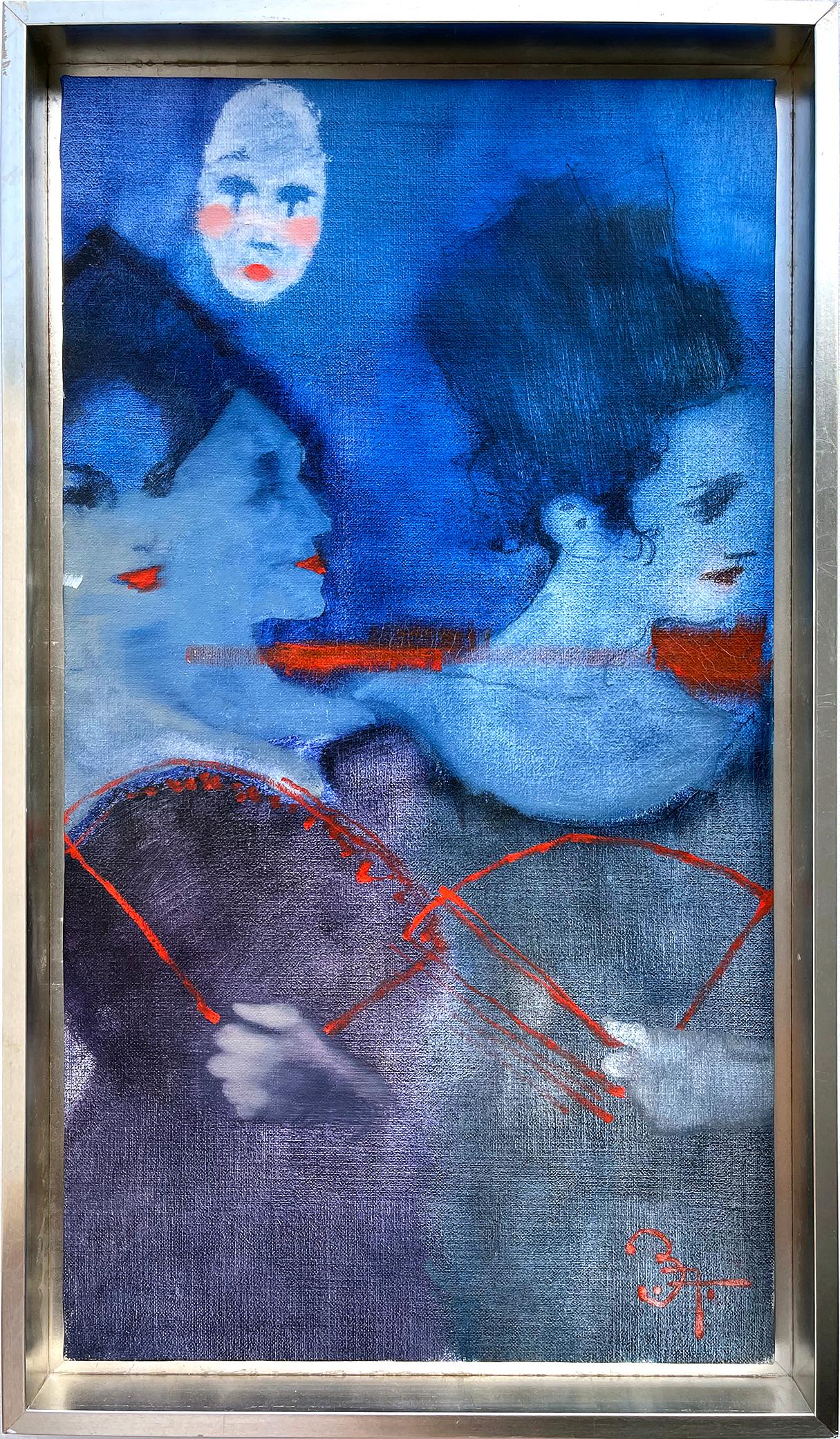Items Similar to Queen Mary Greeting School Children - British 1910 royalty portrait oil painting
Want more images or videos?
Request additional images or videos from the seller
1 of 14
Gerald Spencer PryseQueen Mary Greeting School Children - British 1910 royalty portrait oil paintingCirca 1910
Circa 1910
About the Item
This lovely British Post Impressionist oil painting is by noted artist Gerald Spencer Pryse. Painted circa 1910 the painting depicts Queen Mary greeting a large group of school children. The children and the Queen are in the foreground and buildings beyond. She is dressed in a black coat and white blouse with a neat, decorated black hat with a sliver broach on it. The brushwork on the children's dresses and hair is bold and confident and one clearly gets a sense of their excitement as they crowd forward. A lovely painting by a very talented artist and of historical and social interest.
Signed lower left.
Provenance: From the artist's estate.
Christie's stamp verso.
Condition. Oil on canvas, 20 inches by 16 inches and in good condition.
Frame. Housed in a complementary James Bourlet frame, 27 inches by 23 inches and in good condition.
Gerald Spencer Pryse (1882–1956) was a British artist and lithographer. Born at Ashton, Pryse studied in London and Paris, and first won a prize at the Venice International Exhibition in 1907. In the same year, he joined the Fabian Society, and helped to found The Neolith, a periodical of literature and the fine arts; the journal was printed in lithography. He was a regular exhibitor at the Senefelder Club, and contributed works to Punch, the Strand Magazine, and The Graphic. During the Great War, Pryse produced a considerable body of lithographic work, some of it in colour under the title Autumn Campaign (1914). This was based on his time in France and Belgium at the beginning of the war when he drove around in a Mercedes carrying lithographic stones in the back. He served as a dispatch rider for the Belgian government and was present at the Siege of Antwerp. The artist wrote a memoir of this time entitled Four Days: an account of a journey in France made between 28 and 31 August 1914, published by John Lane in 1932. Pryse also saw some of the Battle of the Marne and the Aisne but was back in Belgium to record the fall of Ostend and the subsequent retirement along the River Yser. Pryse also worked with the Indian Army in France and several of his lithographs depict scenes of Indian troops. Later, he served as a captain in the Queen Victoria's Rifles, King's Royal Rifle Corps, and was mentioned in dispatches. His main action was in the Third Battle of Ypres where he won the Military Cross, the 1914 Star, the Order of the Crown of Belgium, the Croix de Guerre. By the end of 1916, Pryse had made an application to become a war artist, and towards the end of the war, was granted permission to sketch at the front and he was able to record the conditions of trench warfare in numerous water-colour drawings, but many of these were lost in the German offensive of 1918. The remaining drawings were exhibited later in London and were described as having a freshness and authenticity that were not always apparent in the works of the official war artists. Unfortunately, many of these were destroyed by enemy action during the Second World War. He left the regiment at the end of the war but rejoined it in 1921 when the battalion was stationed at Wormwood Scrubs for three months during a coal strike. During the war, he also designed a number of posters including several published by Frank Pick for the Underground Electric Railways Company of London in London, as well as for the Labour Party, The British Red Cross, and for the Empire Marketing Board. One of his most famous posters, entitled The Only Road for an Englishman, shows a regiment of British soldiers marching through a ruined town. Pryse was one of the illustrators selected by Percy Bradshaw for inclusion in his The Art of the Illustrator (1917–1918). He worked in Hammersmith from 1914 to 1925, but in 1925 travelled to Morocco and observed some of the fighting there against the French. He returned to the country and lived there for some years after 1950. Pryse was commissioned in 1924 to create a series of lithographs for the British Empire Exhibition illustrating the extent and variety of life within the British Empire. His work was part of the art competitions at the 1928 Summer Olympics and the 1932 Summer Olympics. In 1932 he married Muriel Anstace Theodora, daughter of the Rev. Laurence Farrall, and they had three daughters, one of whom, Tessa Spencer Pryse, later a landscape artist, became an art student against her father's wishes. He died at Cranford House, Stourton, Worcestershire on 28 November 1956 aged 74.
- Creator:Gerald Spencer Pryse (1882 - 1956, Welsh)
- Creation Year:Circa 1910
- Dimensions:Height: 23 in (58.42 cm)Width: 27 in (68.58 cm)Depth: 2 in (5.08 cm)
- Medium:
- Movement & Style:
- Period:
- Condition:
- Gallery Location:London, GB
- Reference Number:1stDibs: LU853113342482
About the Seller
5.0
Platinum Seller
These expertly vetted sellers are 1stDibs' most experienced sellers and are rated highest by our customers.
1stDibs seller since 2018
402 sales on 1stDibs
Typical response time: 1 hour
- ShippingRetrieving quote...Ships From: London, United Kingdom
- Return PolicyA return for this item may be initiated within 14 days of delivery.
More From This SellerView All
- Family Portrait in Market - British 1914 art Post Impressionist oil paintingLocated in London, GBThis charming early twentieth century Post Impressionist portrait oil painting is by British Jewish female artist Amy Julia Drucker. Of German descent, Drucker was born in England i...Category
1910s Post-Impressionist Portrait Paintings
MaterialsOil
- Tangiers Lemon Market - British 1920's Oriental Figural art oil paintingBy Gerald Spencer PryseLocated in London, GBThis superb vibrant Oriental Post Impressionist oil painting is by noted British artist Gerald Spencer Pryse. It was painted circa 1925 when Pryse first visited Morocco. He was so en...Category
1920s Post-Impressionist Figurative Paintings
MaterialsOil
- Portrait of Water Bearers, Africa - British 1920's Orientalist art oil paintingBy Gerald Spencer PryseLocated in London, GBThis superb vibrant Orientalist Post Impressionist oil painting is by noted British artist Gerald Spencer Pryse. It was painted about 1925 when Pryse was visiting Morocco and Norther...Category
1920s Post-Impressionist Portrait Paintings
MaterialsOil
- Charity - Royal Academy exhib. 19thC art Pre-Raphaelite portrait oil paintingBy Rudolf LehmannLocated in London, GBThis stunning circular 19th century oil painting is by noted prolific Royal Academy exhibited artist Rudolf Lehmann. A portrait artist, German born Lehmann moved to England in 1866 w...Category
19th Century Pre-Raphaelite Portrait Paintings
MaterialsOil
- Portrait of a lady - British 50's Post Impressionist oil painting blonde womanBy Constance Anne ParkerLocated in London, GBA super circa 1955 British portrait oil painting in tones of blue and brown. A very evocative period portrait of a woman painted by British listed female artist Constance Anne Parke...Category
20th Century Realist Portrait Paintings
MaterialsOil
- At the Foot of the Statue - Scottish art Impressionist figurative oil paintingBy William Strang, R.A., R.E.Located in London, GBA fine large oil painting by Scottish listed artist William Strang. This is a super evocative oil on canvas which depicts a family at "The Foot of the Statue". It was exhibited in 1904 in Bradford exhibition of fine arts lent by L W Hodson of Wolverhampton who was a patron of his work. This is a fine example of an early 20th century Scottish oil with good subject. It is a good size and signed. This wouldn't be out of place in Kelvingrove Gallery in Glasgow. Signed lower left. Provenance. Bradford Art Gallery 1904. Sotheby 19th June 2002 Guide price £20000-30000GBP. Condition. Oil on canvas. Image size 30 inches by 25 inches and in excellent condition. Housed in a fine period frame, 39 by 34 inches framed and in good condition. William Strang (1859-1921) was born at Dumbarton, the son of Peter Strang, builder, and educated at the Dumbarton Academy. He worked for fifteen months in the counting-house of a firm of shipbuilders before going to London in 1875 when he was sixteen. There he studied art under Alphonse Legros at the Slade School for six years. Strang became assistant master in the etching class, and had great success as an etcher. He was one of the original members of the Royal Society of Painter-Etchers, and his work was a part of their first exhibition in 1881. Some of his early plates were published in The Portfolio and other art magazines. He worked in many manners, etching, dry point, mezzotint, sand-ground mezzotint, and burin engraving. Lithography and wood-cutting were also used by him to create pictures. He cut a large wood engraving of a man ploughing, later published by the Art for Schools Association. A privately produced catalogue of his engraved work contained more than three hundred items. Amongst his earlier works were Tinkers, St. Jerome, A Woman Washing Her Feet, An Old Book-stall with a Man Lighting His Pipe from a Flare, and The Head of a Peasant Woman on sand-ground mezzotint. Later plates such as Hunger, The Bachelor's End and The Salvation Army were also important. Some of his best etchings were done as series—one of the earliest, illustrating poet William Nicholson's Ballad of Aken Drum, is remarkable for clear, delicate workmanship in the shadow tones, showing great skill and power over his materials, and for strong drawing. Another praised series was The Pilgrim's Progress, revealing austere sympathy with John Bunyan's teaching. Samuel Taylor Coleridge's Ancient Mariner and Strang's own Allegory of Death and The Plowman's Wife, have served him with suitable imaginative subjects. Some of Rudyard Kipling's stories were also illustrated by him, and his likeness of Kipling was one of his most successful portrait plates. Other etched portraits included those of Ernest Sichel and of J.B. Clark, with whom Strang collaborated in illustrating Baron Munchausen...Category
Early 1900s Impressionist Figurative Paintings
MaterialsOil
You May Also Like
- "Bimba in poltrona" olio su cartone cm. 35 x 25 1980 caBy Klara VlassovaLocated in Torino, ITChildhood, Little Girl, Green, Summer KLARA VLASOVA (Moscow, 1926) MUSEUMS St. Petersburg, State Russian Museum Moscow, Pushkin Museum Moscow, Museum of History and Reconstructi...Category
1980s Post-Impressionist Portrait Paintings
MaterialsOil, Cardboard
- Portrait of a Girl in Nature - Mid 20th Century Oil by Michael D'AguilarBy Michael D'AguilarLocated in Watford, HertfordshireBaron Michael D`Aguilar was born on May 15, 1922 in London to Spanish parents. He was brother of the artist Paul D`Aguilar. He spent much of his early life in Spain. He studied at...Category
1940s Post-Impressionist Figurative Paintings
MaterialsOil
- Antique French Fauvist 1920's Signed Oil Painting Portrait of Fashionable LadyLocated in Cirencester, GloucestershirePortrait of a Lady French School, fauvist style indistinctly signed circa 1920's period oil on canvas, unframed canvas: 22 x 18 inches provenance: private collection condition: very ...Category
Early 20th Century Fauvist Portrait Paintings
MaterialsOil, Canvas
- Original French Mid Century Post-Impressionist Oil Painting Portrait Young LadyLocated in Cirencester, GloucestershirePortrait by Édouard Righetti (1924-2001) Signed lower front oil painting on canvas, beautifully painted with rick thick impasto oil and bold colors....Category
Mid-20th Century Post-Impressionist Portrait Paintings
MaterialsOil
- Stylish French Portrait Trendy Young Lady French 1970's Post-Impressionist OilLocated in Cirencester, Gloucestershire''Trendy Young Lady" by Édouard Righetti (1924-2001) Signed lower front, housed in original wooden frame oil painting on canvas, beautifully painted with rick thick impasto oil and ...Category
Mid-20th Century Post-Impressionist Portrait Paintings
MaterialsOil
- Fauve Portrait of Three Women in Blue Holding Red AbanicosBy Bernie FuchsLocated in Miami, FLBernie Fuchs's painting "Fauve Portrait of Two Women in Blue with Red Abanicos" captures a festive scene of three Spanish women in traditional dress at...Category
1960s Fauvist Portrait Paintings
MaterialsCanvas, Oil
Recently Viewed
View AllMore Ways To Browse
Graphic Portrait
German Art Of Children
1919 Portrait
Military Portrait
Antique Oil Painting Red
French Military Paintings
British Empire
French Royalty
John Queen
Large Painting Party
Antique Military Painting
Mary King
Antique Battle Painting
Soldier And War Painting
Large Military Painting
Queen Mary
Queen Crowns
French Empire Paintings
